Scotland Performs Update
Scottish Government performance information
Economy, Jobs and Fair Work Committee
Scorecard
The following National Performance Framework indicators have been selected as relevant to the Economy, Jobs and Fair Work Committee for the purposes of the Draft Budget Consultation Period.
The report overleaf shows recent performance on these indicators as at 14 December 2017.
The hyperlinks take you to the Scotland Performs website for the latest information on each indicator.
Performance Improving
To rank in the top quartile for productivity against key trading partners in the OECD by 2017
Increase real terms productivity in Scotland
Increase the number of businesses
Increase exports
Improve digital infrastructure
Improve knowledge exchange from university research
Reduce the proportion of employees earning less than the Living Wage
Widen use of the internet
Performance Maintaining
To raise the GDP growth rate to the UK level by 2017
To maintain our position in labour market participation as the top performing country in the UK
To match average European ( EU15) population growth over the period from 2007 to 2017
To narrow the gap in participation between Scotland’s best and worst performing regions by 2017 ( cohesion)
To reduce emissions by 42% by 2020 and 80% by 2050 ( sustainability)
Reduce traffic congestion
Improve Scotland’s reputation
Increase research and development spending
Reduce underemployment
Reduce the pay gap
Increase the proportion of young people in learning, training or work
Increase the proportion of graduates in positive destinations
Reduce children’s deprivation
Increase the number of new homes
Reduce Scotland’s carbon footprint
Performance Worsening
To match the GDP growth rate of the small independent EU countries by 2017
To close the gap with the top five OECD countries by 2017 ( participation)
To increase overall income and reduce income inequality by 2017 ( solidarity)
Improve the skill profile of the population
Reduce the proportion of individuals living in poverty
Increase renewable electricity production
Performance Improving
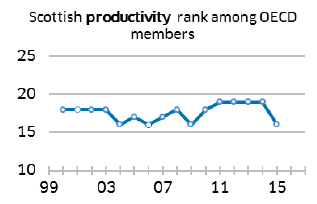
Scotland's productivity rank remained at 19 out of 36 countries between 2011 and 2014, at the top of the third quartile. In 2015, the rank rose to 16 out of 36.
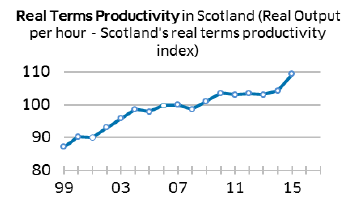
Scotland’s productivity increased by 3.5% in real terms during 2015. It is now 9.4% higher than the pre-recession level in 2007.
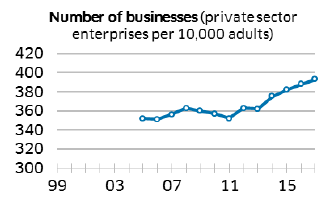
The number of businesses per 10,000 adults has increased over recent years and is now at a series high level.
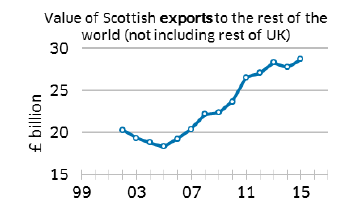
The value of Scottish exports to the rest of the world increased in 2015 as part of a long term upward trend.
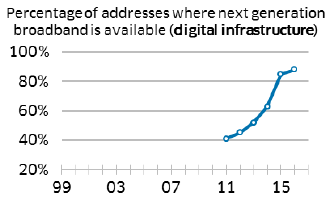
Next generation broadband was available at more premises in 2016 than in the previous five years.
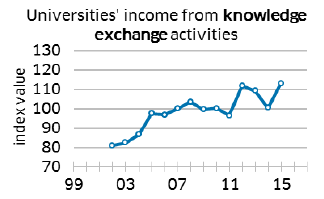
Universities’ income from knowledge exchange ( KE) increased in 2015-16. Fluctuations over time, however, suggest that we should not read too much into one year’s change in the index as some of the components can be quite volatile.
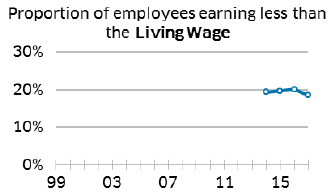
The proportion of employees earning less than the Living Wage decreased in 2017.
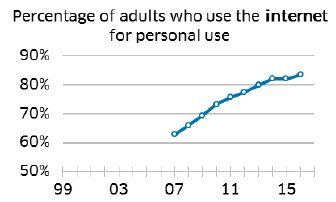
The percentage of adults using the internet for personal use increased in 2016, following a steep upward trend.
Performance Maintaining
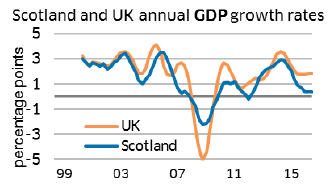
Scotland’s annual GDP growth rate, on a 4Q on 4Q basis, was lower than the comparable UK rate in the first and second quarters of 2017.
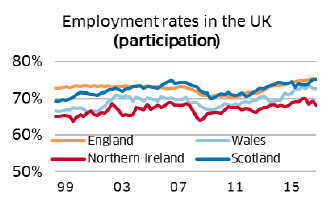
Scotland's employment rate was the second highest in the UK in the second and third quarters of 2017.
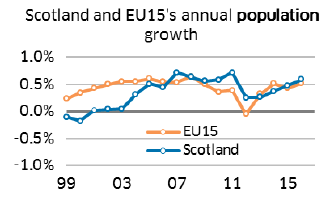
In 2016, the average annual population growth rates since 2007 for Scotland and the EU15 were 0.50% and 0.41% respectively.
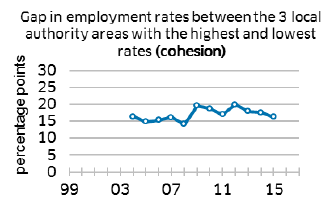
The gap in employment rates between the three local authorities with the highest and lowest rates has declined steadily since 2012.
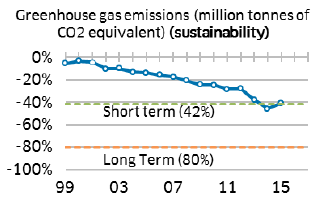
In 2015, Greenhouse gas emissions were 41% lower than the Baseline Period. This is outperforming on the percentage reduction trajectory required to meet the 2020 target (42%) and the 2050 target (80%).
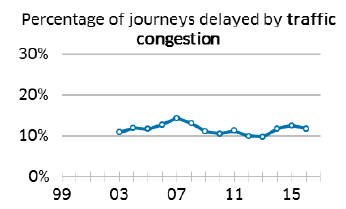
Journeys perceived to have been delayed due to traffic congestion fluctuated between 2007 and 2016.
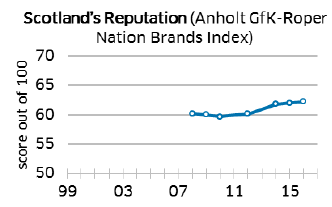
Scotland continues to have a high score for reputation, consistently rated in the top third of the 50 countries evaluated.
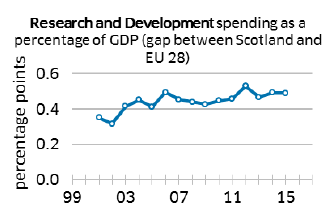
The gap between Scotland and the average EU nations R&D expenditure has widened – since 2001, expenditure in the rest of the EU has increased at a higher rate than that in Scotland.
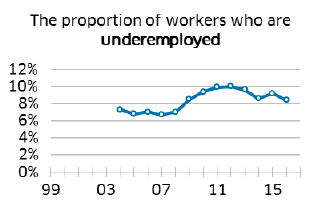
The proportion of workers who are underemployed remained stable between 2015 and 2016, following a declining trend since the peak in 2012. The upward trend in earlier years was due to the recession in 2008.
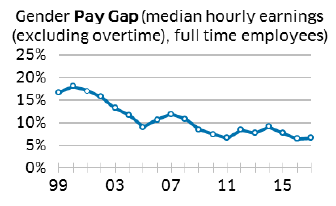
The gender pay gap has gradually decreased since 2000, remaining stable in 2017.
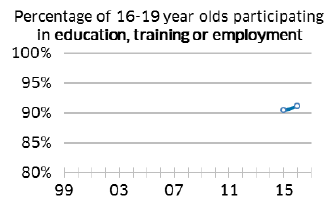
The percentage of 16-19 year olds participating in education, training or employment increased between 2015/16 and 2016/17.
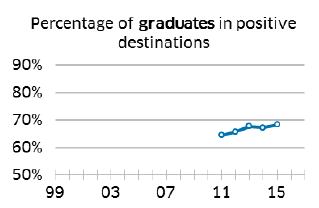
The proportion of graduates in positive destinations remained stable between 2014/15 and 2015/16.
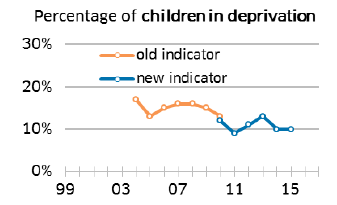
The percentage of children living in material deprivation remained stable between 2014/15 and 2015/16. In 2010/11, there was a change to the questions asked in the survey.
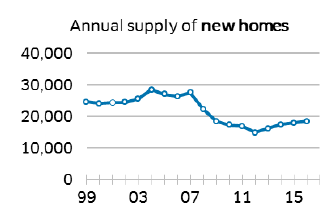
New housing supply remained stable in 2016-17, after increasing since 2012-13. This follows a significant decline between 2007-08 and 2012-13. The downward trend in these earlier years was due to a fall in private rather than social housing.
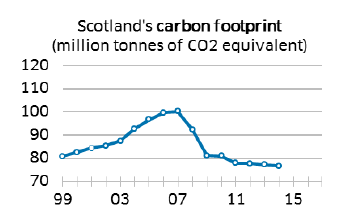
Scotland’s carbon footprint has remained stable since 2011, following a declining trend since the peak in 2007.
Performance Worsening
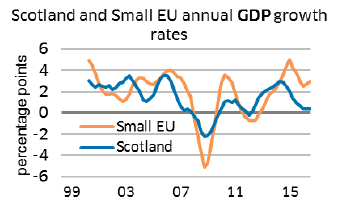
Scotland’s annual GDP growth rate, on a 4Q on 4Q basis, has been lower than that of the Small EU Countries since the third quarter of 2015. The duration and scale of this gap has been influenced significantly by recent revisions to the Republic of Ireland’s GDP time series. For more information please visit scotlandperforms.com.
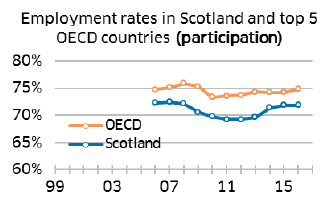
The gap in employment rates between Scotland and the fifth highest OECD country widened in 2016 to 3.0 percentage points.
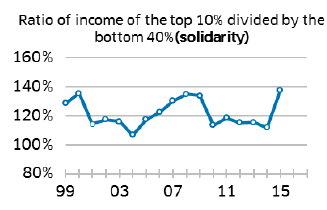
The ratio of income of the top 10% divided by the bottom 40% increased in 2015/16, following a period of stability between 2010/11 and 2014/15.
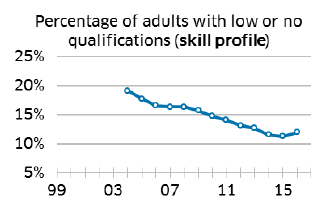
The percentage of the working age population with low or no qualifications has steadily declined since 2004, despite the increase in 2016.
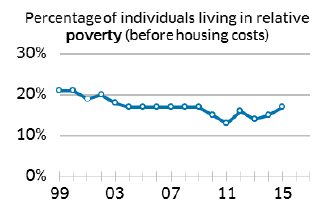
The proportion of people living in relative poverty increased in 2015/16 and has fluctuated since 2009/10.
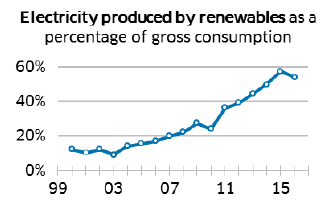
The proportion of Scotland's electricity generated from renewable sources has been increasing fairly steadily since 2003, despite the decrease in 2016.
Contact
There is a problem
Thanks for your feedback